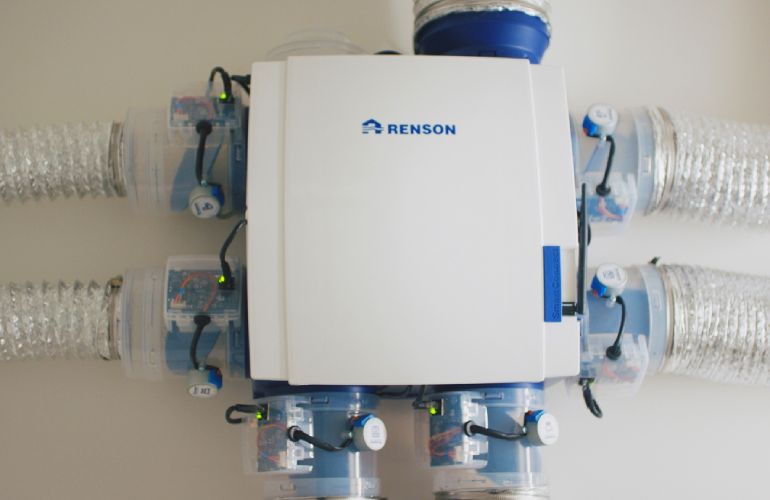We spend about 90% of our day indoors. So the quality of the spaces in which we live is really important. It is our mission to turn every house or living space into a healthy space. With our smart ventilation solutions we can easily realize that. However, people often forget that they spend a lot of time in the office or in class rooms. Unfortunately, those spaces aren’t exactly the healthiest, to say the least. The bad air causes headaches, allergies, respiratory illnesses, fatigue and has a huge influence on the concentration level.
Without ventilation we keep on breathing bad air.
In Australia, the University of New South Wales launched an experimental project, which examined the detrimental effect of bad air on the behavior and learning abilities of pupils. They went further by comparing a class without ventilation system with a class that had a ventilation system. The system that was used was
our smart ventilation unit, Healthbox 3.0.
Bad air quality affects the health of pupils in schools
Research has shown that the indoor air quality is very important in conditions in which children are involved. Children are less resistant to the effects of poor air quality and high indoor air temperatures. There’s a detrimental effect on the productivity of the pupils. Discomfort decreases their attention span. A class full of tired children is not necessarily the fault of the teacher. The lack of oxygen in the air may be the real cause. Bad air quality increases absenteeism in schools with 10 – 20%.

The quality of the air is often based on the CO2 (expressed in ppm – part per million) level in the air. The generally accepted CO2 level norm is 1000ppm. In the research of the UNSW results of 1500 ppm were measured. Other research has even shown CO2 levels up to 4000 ppm. Those numbers show that the air quality in schools is nothing less than problematic.
Even more harmful: VOCs (volatile organic compounds)
It goes even further, the air in class rooms is full of VOCs.
VOCs are chemicals that that easily become vapors or gases. One of the most common and at the same time harmful substances is formaldehyde. This chemical is used in building materials and household products. High levels of this product can cause burning sensations in the eyes and throat, nausea and respiratory problems. But those are the short-term effect. In the long run, formaldehyde is carcinogenic. So, can you imagine the effect on pupils when they are locked up in an unhealthy environment like that for 7 – 8 hours/day? That’s the reason why the effects on pupils are often described as the ‘sick school syndrome’.
Airconditioning without ventilation
The often hot Australian climate doesn’t make the situation any better. In order to keep the classrooms fresh, AC systems often function at maximum capability. When the airconditioning is turned on, all doors and windows are closed. The effects on the air quality is disastrous. Or to put it in the words of project leader Mattheos Santamouris: “Airconditioning without ventilation for schools is the worst possible solution.” In order to keep a school cool,
there are other possibilities as well.
Why schools need a smart ventilation system
The experiment was also looking for a way to improve the indoor air in classrooms. They created a test group – a classroom without a ventilation system – and they had a class with a ventilation system. They chose the Renson Healthbox 3.0 to that purpose.
The Healthbox 3.0 is a smart ventilation system. It constantly measures the air quality. The ventilation unit contains sensors that detect CO2, humidity and VOCs. When the system detects such substances, it will automatically extract them. When extracted, the system will replace them with fresh, healthy outdoor air. The purpose of this smart system is to unburden the user. He can simply lean back and enjoy the healthy air. Things go even further, the system comes with an online app. Thanks to the app, the user can monitor the air quality and can even increase/diminish it if he/she wishes to. In schools, the system can be connected to the school network and the results (the air quality in the different classrooms) can be checked on a web portal.

Another advantage of this system that should be mentioned, is that the Healthbox 3.0 is the most energy-efficient system on the market. The system ‘notices’ when there are people in the room or not. When there are no people, the system functions on the lowest level. When there are much people present, there will be more ventilation in that room.
Ventilation a necessity in classrooms
The research of the UNSW showed significant improvements in reducing CO2 levels and VOCs in classrooms with ventilation system versus the classroom without the Renson Healthbox 3.0. The researchers also examined the well-being and the fatigue of the pupils through several surveys. The classroom with ventilation clearly scored better.

Not only did the Healthbox 3.0 improve the productivity of the pupils, it also increased their well-being and health. In the long run, the system will bring back the level of absenteeism in schools. So the investment will pay itself back. Education policy makers – and policy makers in general - should really look into the results of this research and draw conclusions. As decision makers, they are in the right position to make the lives of our children better and healthier.
The full
UNSW research paper
can be found here.
More information on the Healthbox 3.0 can be found here:
www.renson.eu/gd-gb/products/ventilation.
Any questions? Contact Frank Goudman (
+32 474 74 68 18 or
frank.goudman@renson.be)